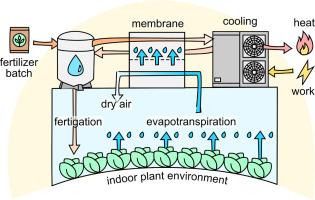使用新型肥料基液体干燥剂系统对室内植物环境除湿的能源效率:实验分析
IF 9.5
Q1 ENERGY & FUELS
引用次数: 0
摘要
在温室和室内农场等受控环境中种植植物比田间农业具有若干优势,因此可以成为提高全球粮食系统可持续性的重要组成部分。在室内环境中进行有效栽培的要求之一是需要控制湿度,但通常与除湿相关的能源成本很高。在本研究中,我们评估了一种新型除湿概念的能源效率,该概念使用冷浓缩肥料作为膜基接触器中的液体干燥剂溶液。这是有史以来第一次对该过程的能源效率进行实验分析——我们将其定义为冷却干燥剂所需的能量与从室内环境中去除的水蒸气量的关系。在实验室测试中,当超浓硝酸钙溶液保持在8°C时,观察到每克水蒸气的比能量消耗低至1.45 Wh。假设性能系数为5,这意味着比功仅为0.29 Wh/g。随着肥料溶液批次的循环,浓度下降,比功增加到0.40 Wh/g。需要调整肥料温度,以尽量减少具体工作,以响应变化的浓度是清楚显示的。还对几种多离子混合肥料进行了试验,观察到类似的结果。与其他除湿技术和标准相比,这些节能结果非常有利,表明基于肥料的除湿有一个很好的未来。本文章由计算机程序翻译,如有差异,请以英文原文为准。

Energy efficiency of using a novel fertilizer-based liquid desiccant system to dehumidify indoor plant environments: An experimental analysis
Plant cultivation in controlled environments such as greenhouses and indoor farms has several advantages over field agriculture and can therefore be an important part of improving the sustainability of global food systems. Among the requirements for effective cultivation in indoor environments is the need to control humidity, but in general the energy cost associated with dehumidification is high. In this study, we evaluate the energy efficiency of a novel dehumidification concept that uses cold concentrated fertilizer as a liquid desiccant solution in a membrane-based contactor. This is the first ever experimental analysis of the process’ energy efficiency – which we define as the amount of energy required to cool desiccant relative to the amount of water vapor removed from the indoor environment. Specific energy use as low as 1.45 Wh per g of water vapor, is observed during laboratory testing when super concentrated calcium nitrate solution is maintained at 8 °C. Assuming a coefficient of performance of 5, this translates to specific work of only 0.29 Wh/g. As the batch of fertilizer solution is recirculated and concentration drops, specific work is found to increase to 0.40 Wh/g. The need to adjust fertilizer temperature to minimize specific work in response to changing concentration is clearly shown. Testing is also conducted with several multi-ion fertilizer blends, and similar results are observed. These energy efficiency results compare very favorably with other dehumidification technologies and standards, suggesting a promising future for fertilizer-based dehumidification.
求助全文
通过发布文献求助,成功后即可免费获取论文全文。
去求助
来源期刊

Energy nexus
Energy (General), Ecological Modelling, Renewable Energy, Sustainability and the Environment, Water Science and Technology, Agricultural and Biological Sciences (General)
CiteScore
7.70
自引率
0.00%
发文量
0
审稿时长
109 days
 求助内容:
求助内容: 应助结果提醒方式:
应助结果提醒方式:


